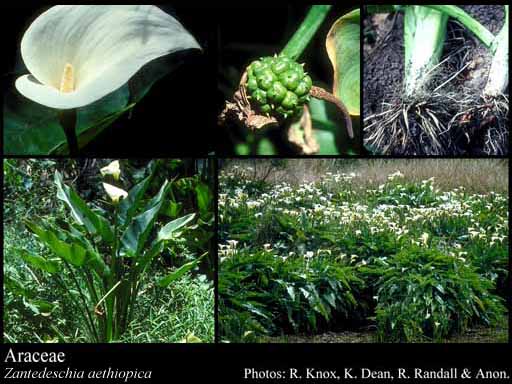- Reference
- Gen.Pl. [Jussieu] 23 (1789)
- Name Status
- Current

Scientific Description
Common name. Arum Family.
Habit and leaf form. Shrubs, or herbs, or herbaceous climbers, or ‘arborescent’; laticiferous, or with coloured juice, or non-laticiferous and without coloured juice. Perennial; plants with a basal concentration of leaves, or with neither basal nor terminal concentrations of leaves; often cormous, or rhizomatous, or tuberous. Self supporting, or epiphytic, or climbing (some very large); when climbing stem twiners, or root climbers, or scrambling. Hydrophytic, or helophytic, or mesophytic; when hydrophytic rooted, or free floating (Pistia). Leaves when hydrophytic, submerged, or emergent. Heterophyllous (often entire/lobed compound), or not heterophyllous. Leaves small to very large; alternate; spiral, or distichous; petiolate (appearing conventionally ‘petiolate’ when the sheath shed), or sessile (Pistia only); sheathing (the sheath membranous, sometimes deciduous). Leaf sheaths with free margins. Leaves with ‘normal’ orientation (Acorus being excluded); simple, or compound. Leaf blades pinnately veined, or palmately veined, or parallel-veined; cross-venulate, or without cross-venules; often cordate, or hastate, or sagittate. Leaves ligulate, or eligulate. Axillary scales present, or absent. Leaves without a persistent basal meristem; often becoming compound by necrosis. Vegetative anatomy. Plants without silica bodies. Leaf anatomy. Guard-cells not ‘grass type’. Stem anatomy. Secondary thickening absent. Roots. Roots with velamen (rarely), or without velamen.
Reproductive type, pollination. Fertile flowers hermaphrodite, or functionally male and functionally female, or hermaphrodite and functionally male, or hermaphrodite and functionally female, or functionally female, or hermaphrodite, functionally male, and functionally female. Unisexual flowers present, or absent. Plants hermaphrodite, or monoecious (then the males above), or andromonoecious, or gynomonoecious, or gynodioecious, or polygamomonoecious. The unisexual flowers when monoecious, aggregated in different parts of the same inflorescence. Anemophilous (rarely), or entomophilous. Pollination mechanism conspicuously specialized (involving protogyny, combined with the trapping of insects in the spathe, and their subsequent release), or unspecialized.
Inflorescence and flower features. Flowers aggregated in ‘inflorescences’; in spikes (very rarely shortly pedicellate — Pedicellarum). The terminal inflorescence unit seemingly racemose. Inflorescences scapiflorous (usually, more or less), or not scapiflorous; consisting of specialised spikes (‘spadices’) with spirals or rarely whorls of flowers, variously pedunculate, sometimes tipped by a naked ‘appendix’; usually conspicuously, often spectacularly spatheate, or espatheate (in that there may be no true spathe in Gymnostachys, Orontium). Flowers ebracteate; ebracteolate; small (numerous); (these or the spadix) often fragrant, or malodorous; regular to very irregular; when irregular, asymmetric; 1–3 merous; cyclic. Perigone tube present (Spathiphyllum), or absent (usually). Perianth of ‘tepals’, or absent; 0, or 4, or 6, or 8 (rarely 12); when present, 2 -whorled (3+3 or 2+2); isomerous; free; when present, sepaloid; similar in the two whorls (small, inconspicuous, often thick). Fertile stamens present, or absent (when female). Androecium 1 (e.g. Cryptocoryne), or 4, or 6, or 8(–12). Androecial members free of the perianth; free of one another, or coherent; 1 -whorled, or 2 -whorled (commonly 3+3 or 2+2). Androecium exclusively of fertile stamens. Stamens 1–4, or 6, or 8–12; reduced in number relative to the adjacent perianth to isomerous with the perianth to triplostemonous. Anthers basifixed; non-versatile; dehiscing via pores, or dehiscing via short slits, or dehiscing via longitudinal slits, or dehiscing transversely; extrorse; bisporangiate, or tetrasporangiate. Pollen shed in aggregates (occasionally), or shed as single grains; when in aggregates, in tetrads (e.g. Caladium, Xanthosma). Fertile gynoecium present, or absent (when male). Gynoecium (1–)3(–8) carpelled. The pistil (1–)3(–8) celled. Gynoecium monomerous, or syncarpous; of one carpel, or synstylovarious to eu-syncarpous; superior. Carpel non-stylate; apically stigmatic; (when monomerous,) 1–5 ovuled. Placentation apical, or marginal, or basal. Ovary unilocular, or plurilocular; when syncarpous (1–)3(–8) locular. The ‘odd’ carpel when trilocular, posterior. Gynoecium shortly non-stylate, or stylate. Styles apical. Stigmas wet type, or dry type; non-papillate; Group II type. Placentation when syncarpous/unilocular, parietal, or basal, or apical; when plurilocular, axile. Ovules in the single cavity when unilocular, 1–15(–50); 1–15(–100) per locule; pendulous, or horizontal, or ascending; orthotropous, or hemianatropous (rarely), or anatropous.
Fruit and seed features. Fruit fleshy (usually), or non-fleshy; an aggregate, or not an aggregate. The fruiting carpel when monomerous, indehiscent; drupaceous, or baccate, or nucular. Fruit indehiscent (usually), or dehiscent; a capsule to capsular-indehiscent (occasionally), or a berry, or a drupe, or a nut (occasionally). Capsules when present, splitting irregularly. Gynoecia of adjoining flowers combining to form a multiple fruit (usually), or not forming a multiple fruit. The multiple fruits coalescing (sometimes), or not coalescing. Dispersal unit the fruit, or the inflorescence (the spadix sometimes forming a syncarp). Seeds endospermic, or non-endospermic. Endosperm when present, oily (and starchy). Perisperm absent. Seeds with starch. Cotyledons 1. Embryo chlorophyllous (6/6), or achlorophyllous (Arisaema amurense); straight (linear). Seedling. Hypocotyl internode present, or absent. Mesocotyl absent. Seedling collar not conspicuous. Cotyledon hyperphyll compact; assimilatory, or non-assimilatory. Coleoptile absent. Seedling non-macropodous. First leaf dorsiventral. Primary root ephemeral.
Physiology, biochemistry. Photosynthetic pathway: C3.
Geography, cytology, number of species. World distribution: widespread. 2000 species.
Economic uses, etc. The family furnishes numerous horticultural ornamentals, especially for indoors, and a few are grown for food — e.g. Colocasia for taro, Monstera for its ‘fruits’ (‘Mexican breadfruit’).